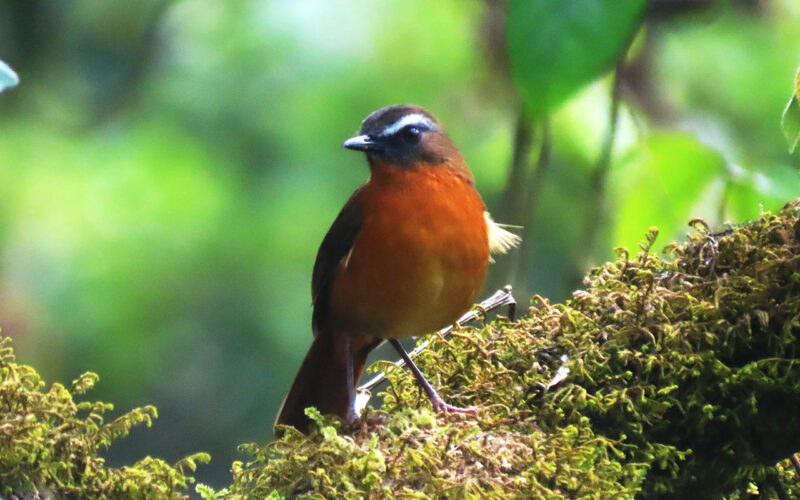Birding in Uganda is a rewarding expereince, unmatched on the continent due to the country’s geographic location at the confluence of Africa’s top biomes or habitats that host a checklist of over 1080 bird species. And blessed with an all-year-round pleasant equatorial weather, great connectivity between top birding hotspots and excellent local guides, Uganda is a rewarding birding destination.
The Albertine Rift Endemic Area
Covering the entire western countryside of Uganda, the Albertine Rift is the most biologically diverse ecosystem on the African continent protecting various endemic flora and fauna of which several are globally regarded as critically endangered and facing near extinction. This diversity of endemism include the world’s population of the endangered mountain gorilla, close to 90% of the Eastern chimpanzee population, the endemic golden monkey, butterflies, plants and more.
Uganda offers the safest and best access to explore the bird-rich hotspots that lie within the Albertine Rift. These bird hotspots are characterized by a wide range of habitats from ancient montane tropical rainforests, lowland moist evergreen forests and mid-altitude forests. Other notable features include Africa’s highest mountain ranges the Rwenzoris, expansive woodlands and savannas, volcanic mountain ranges and Africa’s major lakes. The Albertine Rift endemic area host a total of 37 restricted range bird species where up to 24 Albertine Endemic species occur in Uganda.
Birding Hotspots and sites along the Uganda’s Albertine Rift Endemic Zone
All our specialized Uganda birding tours for Albertine Endemics are tailored with ample time to explore these hotspots for a chance to twitch all the 24 species of Albertine Endemic Zone and other specialties restricted to these eco zones. Of these birding hotspots, are ancient montane rainforests that offer Uganda’s top bucket-list activities namely; the mountain gorilla and chimpanzee trek experiences thus offering an advantage of great access and excellent amenities.

-
The Bwindi Impenetrable Forest National Park
Bwindi Impenetrable Forest is Uganda’s premier birding site with a checklist of over 360 bird species including the 23 Albertine Endemics. The ancient forest park spreads over altitudes of 1965-2987m covering various forests types from mid-altitude evergreen to montane, bamboo and high-altitude swamps stocking a variety of local bird specialists. Tailored Uganda birding tours to here normally require up to 4-Days with popular sectors of Buhoma and Ruhija preferred due to the quality of established trails and local bird guides.
Top sightings include, Red-throated Alethe, Neumann’s Warbler, Strange Weaver, Kivu Ground Thrush, Dwarf Honeyguide, Red-throated Woodland Warbler, Blue-headed Sunbird, Yellow-eyed Black Flycatcher are easily seen around the main trail at Buhoma.
Birding at Ruhija sector, Bwindi Forrest’s highest altitude trail-head the checklist includes, Stripe-breasted Tit, Regal Sunbird, Northern-Double Collared Sunbird, Handsome Francholin, the beautiful and neat African Green Broadbill is recorded along the main trails descending down to the swamp where Grauer’s Swamp Warbler is twitched with several other wetland restricted species.
Noisy Doherty’s and Lagden Bushshrikes thou not endemics are seen on the sloppy and scrubby trail, the Grauer’s Warbler, Dusky and Shelley’s Crimsonwing, Purple-breasted Sunbird, Blue-headed Sunbird, Rwenzori Batis, Chapin’s Flycatcher, Rwenzori Apalis, Mountain-masked Apalis and more…Eliot’s and Fine-banded Woodpeckers, Mountain Illadopsis, Mountain-Hill Babbler, skulky Blue-shouldered Robin, Dusky Twinspot, and noisy Stulmann’s Starlings, Collared sunbird, Purple-throated and Grey Cuckoo shrikes should entertain us on the descent trail.
-
Mgahinga Gorilla National Park
Uganda’s smallest park, Mgahinga Gorilla NP is located at the south-west tip of Uganda protecting the Ugandan mountain ranges of the Virunga mountain ranges chain shared by the Rwanda and the DRC. Here we bird the trails criss crossing these slopes up to the saddle known as The Gorge in between the dormant volcanic mountains of Sabyinyo and Gahinga where Handsome Francolin, Rwenzori Turaco, Archer’s Robin, Rwenzori and Mountain-masked Apalis, Regal Sunbird, Strange Weaver are usually encountered with ease.
Just like Bwindi, several other restricted range and afro-tropical species occur making a list up to 200 bird species. The bamboo slopes also host several Golden Monkey troops encountered along the edges of Bamboo Zones about 2300m. The total Albertine endemics (ARE) on this location are 14 bird species.
-
Echuya Forest Reserve
Echuya Forest Reserve lying between Mgahinga NP and Bwindi Forest is an excellent birding hotspot that features on all our tailored birding trips where we target all the 14-species of Albertine endemics known from here. Echuya Forest is an evergreen tropical highland forest that spreads over various mountain ranges and protects one of the biggest highland swamp ( 2200m) which is a known breeding site for Grauer’s Rush Warbler and other swamp specialists. Other bird highlights include Regal Sunbird, Doherty’s Bush-shrike, Rwenzori Batis, White-starred Robin, Eliot’s Woodpecker and Handsome Francolin more Afrotropical highland species.
Other birding hotspots along the Albertine rift and worthy a visit while birding here include; Queen Elizabeth NP, Rwenzori Mountains NP, Kibale Forest NP, Bugoma Forest, Forest and Imaramagambo Forest.
List of the Albertine Rift Endemics in Uganda
On a tailormade Albertine Endemics Birding Safari in Uganda, these are ARE that one can encounter;
- Handsome Spurfowl (Pternistis nobilis) LC
- Rwenzori Turaco (Turaco johnstoni) LC
- Rwenzori Nightjar (Caprimulgus ruwenzori)
- Dwarf Honeyguide (Indicator pumilio) NT
- African Green (Grauer’s)Broadbill (Pseudocalyptomena graueri)VU
- Red-throated Alethe (Chamaetylas poliophrys)
- Archer’s Robin-chat (Dessonornis archeri)
- Grauer’s Warbler (Graueria vittata)
- Nuemann’s Warbler (Hamitesia nuemanni)
- Rwenzori Apalis (Oreolais ruwenzorii)
- Montane Masked (Apalis personata)
- Red-faced woodland Warbler (Phylloscopus laetus)
- Grauer’s Swamp Warbler (Bradypterus graueri)EN
- Yellow-eyed Black-flycatcher (Melaenornis ardesiacus)
- Chapin’s Flycatcher (Muscicapa lendu)
- Rwenzori Batis (Batis diops)
- Stripe-breasted Tit (Parus fasciiventer)
- Blue-headed Sunbird (Cynomitra alinae)
- Regal Sunbird (Cinnyris regia)
- Purple-breasted Sunbird (Nectarinia purpureventris)
- Rwenzori Double-Collared Sunbird (Stuhlmann) (Cinnyris stuhlmanni)
- Dusky Crimson-wing (Cryptospiza jacksoni)
- Shelly’s Crimson-wing (Cryptospiza shelleyi)VU
- Strange Weaver (Ploceus alienus)
- Dwarf Honeyguide (Indicator pumilio)
- Willard’s Sooty boubou (Laniarius willardi)
- *Kivu Ground-thrush (Geokichla tanganjicae) included here is often considered a full species by several authorities while others treat it as a distant Albertine race of a more widespread Abyssinian Ground-Thrush (Geokichla piaggiae)
